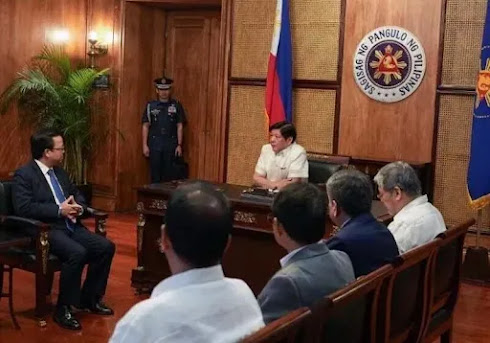Marcos summons China’s envoy in response to the laser incident
President Ferdinand Marcos Jr. summoned the Chinese Ambassador to the Philippines, Huang Xilian, on Tuesday, February 14, after China used a military-grade laser on the Philippine Coast Guard.
The summoning of an ambassador by a head of state, as opposed to a foreign minister, is one of the strongest diplomatic protests against a foreign government.
“The President summoned Chinese Ambassador Huang Xilian this afternoon to express his grave concern over the increasing frequency and intensity of Chinese actions against the Philippine Coast Guard and Filipino fishermen in their bancas, the most recent of which was the use of a military-grade laser against our Coast Guard vessels,” Malacanang said in a statement on Tuesday.
Since April 2021, this is the third time that Huang has been called by Manila. In two earlier cases, he was summoned to the Department of Foreign Affairs’ headquarters.
This is also the first time in recent years that a Philippine president has summoned a Chinese ambassador. Despite requests for him to do so, Marcos’ predecessor, Rodrigo Duterte, did not summon Chinese diplomats throughout his six years in government, even after a Chinese vessel collided with a Filipino fishing boat in 2019.
The decision to call Huang was made by Marcos a day after the Philippine Coast Guard revealed that the China Coast Guard had fired a military-grade laser on the BRP Malapascua near Ayungin Shoal in the West Philippine Sea.
The event, which occurred on February 6 of last year, resulted in “temporary blindness to her bridge crew” and was accompanied by risky movements against the PCG ship.
The Department of Foreign Affairs said earlier on Tuesday that a diplomatic protest had been lodged against China for its “acts of aggression” against the Philippine Coast Guard in the West Philippine Sea.
The rise of hostilities occurs shortly after Marcos concluded his state visit to China at the beginning of January. The 48-hour journey resulted in an agreement to establish a direct line of communication between the DFA’s Maritime and Ocean Affairs Office and the Chinese foreign ministry’s Department of Boundary and Ocean Affairs in order to control tensions in the dangerous waterway.
It also follows Marcos’ recent official visit to Japan, during which he and Japanese Prime Minister Fumio Kishida pledged to strengthen defense relations as part of efforts to enhance regional security. Tokyo, like Manila, is embroiled in a territorial conflict with Beijing in the East China Sea, where China has employed strong methods.
China’s deployment of a military-grade laser against the PCG was one of the rare instances that documented and provided evidence of China’s laser usage against foreign ships and aircraft. In February of 2012, Australia accused Beijing of committing an “act of intimidation” after a Chinese navy vessel aimed a laser at an Australian military surveillance plane.
In his first State of the Nation Address, Marcos swore to maintain a policy of being “friend to everyone and foe to none,” but emphasized that his administration would not cede “even a square inch of Philippine land” to any foreign entity.
Under the Marcos administration, Manila lodged at least seventy-five diplomatic grievances against Beijing.
China’s deployment of a military-grade laser on the PCG was one of the few reported occurrences that served as evidence of China’s use of lasers against foreign ships and aircraft. In February of 2012, Australia accused China of committing a “act of intimidation” after a Chinese navy vessel aimed a laser at an Australian military surveillance aircraft.


Comments
Post a Comment